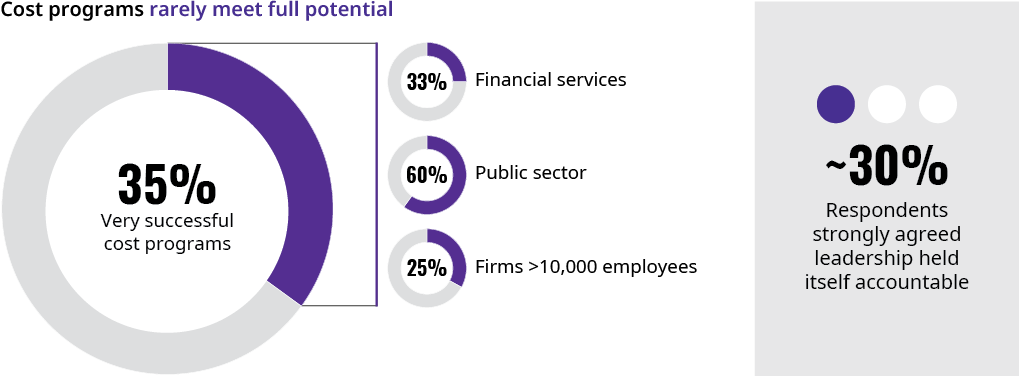This article was first published on July 30, 2020.
The shock of COVID-19 and containment measures have plunged the global economy into a severe contraction. According to World Bank forecasts, the global economy will shrink by 5.2 percent in 2020. As a result, cost management has become a priority on the agenda of many CEOs, who are faced with the reality that cuts must take place for their firm to survive, much less thrive. This places huge pressure on organizations to get cost management right.
Our analysis reveals that about 90 percent of the Fortune Top 50 companies1 have announced a cost action since the beginning of the pandemic, and it’s likely that even more will follow suit in the third quarter of 2020, as forecasts of global demand worsen.
Exhibit 1: COVID-19 related cost actions1 from top US companies and EMEA banks
1. Covering February 24 to July 6th
Source: Oliver Wyman Cost survey, June 2020
Under pressure, most organizations tend to retreat to brute-force cost-cutting. Winners in a crisis tend to take a more deliberate approach and focus on structurally transforming their cost base so that gains are sustainable.
Oliver Wyman conducted a survey2 to highlight cost programs that differentiate themselves from the rest. We selected a panel of cross-industry participants who had personally overseen or taken part in cost reduction programs to gather their insights into what works and what doesn’t.
From plan to impact
More than 81 percent of respondents agreed that their firm had a clear and well-planned approach to their cost program, but only 35 percent of participants believe their cost program was very successful. Even a good plan is not enough – in fact, companies that did not have a successful program were just as likely to think they had as strong a plan as the rest of the respondents.
Exhibit 2: What does it take to run a successful cost program?


Source: Oliver Wyman Cost survey, June 2020
Based on our research and recent cost management experiences with some of the world’s largest organizations, we’ve identified four core strategies for a successful cost transformation.
1. Take into account program complexity when providing resources
Organizations often underestimate the capacity required to execute cost programs: only 30 percent of respondents gave their organization full marks for providing the tools, training, and resources to implement the program effectively. While it can feel odd to spend resources on a cost agenda, employees that are unprepared and spread too thin will struggle to coordinate, make the right decisions, and execute in a timely fashion. Analyzing costs and benefits can give organizations the confidence to properly resource their cost programs for successful delivery.
2. Provide constant and transparent communication
Successful programs were almost twice as likely to have leadership that communicated about the program regularly both to internal and external stakeholders. And indeed, when a large US global bank reported on its cost program at every quarterly earnings release over a four-year period, its net efficiency ratio improved by 16 percentage points, greatly exceeding the peer group average.
3. Align individual and firm incentives
One-third of survey respondents were not motivated to support cost programs since they didn’t see the personal benefit. “While managing costs, it’s critical to align incentives so that success criteria for an individual part of the business is the same for the overall bank, and vice-versa,” says Ken Harvey, Chairman of the Board at CLS Group and prior group head of technology and operations at HSBC. Incentives programs need to include cost management metrics in careful balance with other elements of performance.
4. Promote ownership and accountability
Almost 90 percent of survey respondents agree that leaders holding themselves accountable for cost program results drives program outcomes, more than any other factor. The culture of accountability must not be limited to members of the C-suite either; the next levels down must be equally engaged and incentivized to deliver on cost commitments, even though they generally aren’t setting the cost management mandate. With today’s technology, institutions can build the tools and infrastructure that put cost information into every manager’s hands in support of this accountability.
The time to act is now
The second half of 2020 will be more volatile than the first, and most organizations will continue to be under significant duress. More than 75 percent of Fortune 500 CEOs don’t think economic activity will meet its pre-pandemic levels until 2022. If you are like most companies, you have a cost reduction plan in motion but are not going to see the full results you planned for. Fortunately, you can course-correct now by building the analytical foundation and supporting infrastructure for cost management to set resource levels, enable communication, align incentives, and establish accountability for achieving results.
1. Data from covering February 24th 2020 to July 15th 2020 period
2. Survey included respondents from the following industries: Education, Financial Service, Government, Professional Services, Hotel/Leisure, Retail





